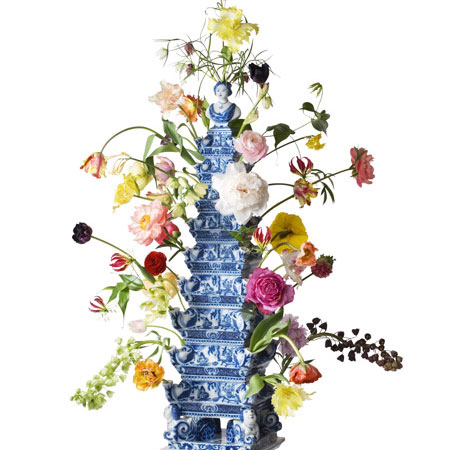Milan 08: Hella Jongerius, Jurgen Bey, Studio Job and Alexander van Slobbe have re-interpreted traditional Dutch 17th century flower pyramids (above) for ceramic manufacturers Royal Tichelaar Makkum.
The starting point for the project was an exact copy of a traditional pyramid made by Royal Tichelaar Makkum as part of a restoration project for the Amsterdam Rijksmuseum. Above: Hella Jongerius
Seven of each design have been made. Above: Studio Job
Above: Jurgen Bey
Here's some more information from Royal Tichelaar Makkum:
--
Royal Tichelaar Makkum presents ‘Pyramids of Makkum’
In the wake of an elaborate restoration project for the Amsterdam Rijksmuseum, of 17th century flower pyramids which it had then recently acquired, Royal Tichelaar Makkum carried out a prestigious project with pyramids of its own. Tichelaar’s craftsmen began by making an exact replica of one of the original pyramids, which subsequently served as starting point for a new interpretation by Hella Jongerius, Jurgen Bey, Studio Job and Alexander van Slobbe. The results will be exhibited for the first time at the Salone del Mobile of Milan, next April 16th to 20th.
Above: Alexander van Slobbe
Its expertise, going back four centuries, qualifies Royal Tichelaar Makkum as the only company in the world capable of restoring rare pieces of 17th and 18th century Delftware. Flower pyramids are especially considered to be the finest specimen of ceramic art of the period. Only a few of such ca 1.60m tall piled-up vases have survived; some made for Mary Stuart, spouse to Dutch Stadtholder Prince William III, who in 1689 ascended the British throne. These complex, richly embellished pieces of art ooze ostentation. The designs, influenced by Western as well as Oriental art forms, were very fashionable at the time. Such pyramids were used to show as great a diversity of flowers as conceivable.
Above: Jurgen Bey
While restoring the Rijksmuseum’s objects, Royal Tichelaar developed the exact colours, gloss and brush technique of the period, which enabled the craftsmen to compose a faithful reproduction. With the intention of making the most of the acquired expertise beyond the field of mere restorations, Royal Tichelaar commissioned the affiliated Dutch designers Hella Jongerius, Studio Job, Jurgen Bey and Alexander van Slobbe, to use this replica as starting point for modern interpretations of the traditional flower pyramids.
The result is a most impressive presentation of five sublime artefacts: the traditional replica and the four interpretations, all made in the original Faience technique. Of each flower pyramid, only seven have been made and after the Milan exhibition they will be shown at the ICFF in Murray Moss’ New York gallery. The first series of five has already been acquired by the Zuiderzee Museum of Enkhuizen, the Netherlands, which greatly helped realising the project.
Royal Tichelaar Makkum is the Netherlands’ longest existing company, which takes its long history serious without being bogged down by it. Invaluable ceramic knowledge and experience have through the centuries been handed down from father to son. This process is still going on, while Royal Tichelaar, more than ever, emphasises that product development must go hand in hand with cultivation of knowledge.
Room for experiment and research, and the ability to make a wide variety of ceramic products to demanding specifications, are the pillars of a company policy that aims at adding cultural value for architects as well as consumers. Traditional craftsmanship, modern design and forward looking research have durably joined forces in Makkum.
Exhibition during Salone del Mobile: April 16th to 20th/Via dell’ Orso 16, Milan, Italy.
Open: daily 10.00 to 20.00 hrs.

